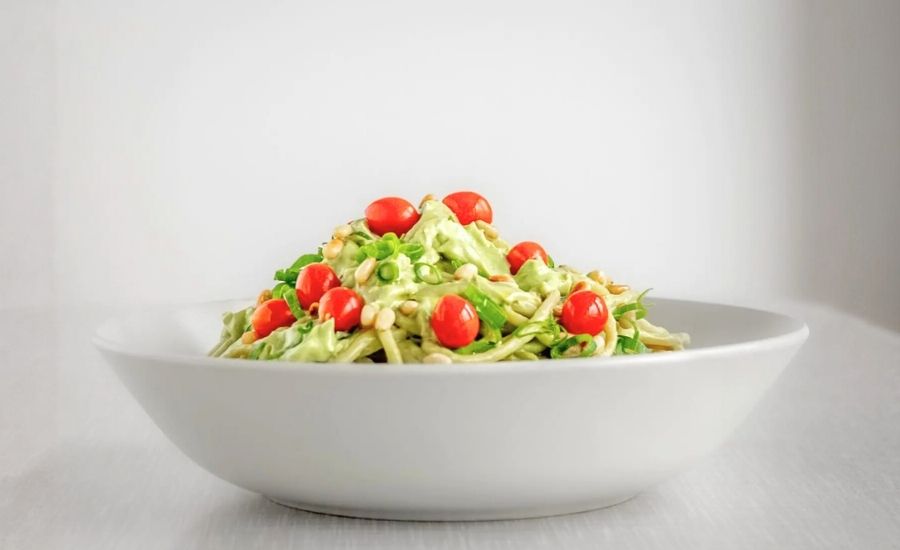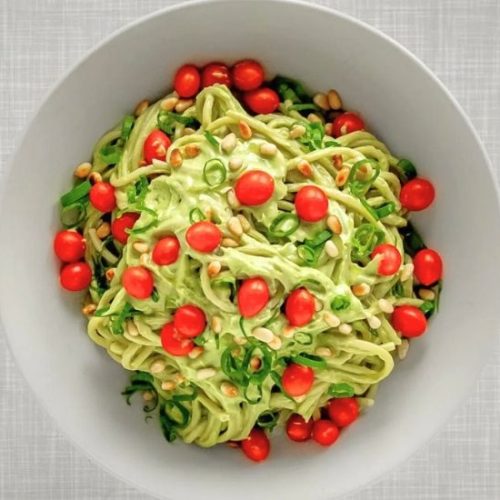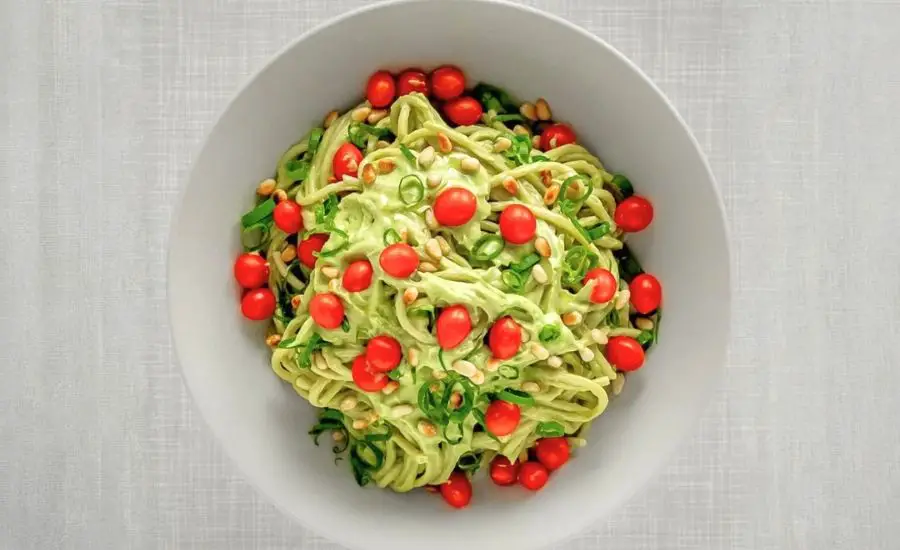All products are selected by our editorial team for quality. If you buy through our links, we may earn a small commission at no extra cost to you.
This creamy vegan avocado pasta, affectionately dubbed “guacaghetti,” is a refreshing twist on traditional pasta dishes that combines simplicity with nutrition.
The luscious avocado-based sauce offers a rich source of heart-healthy monounsaturated fats, which support cardiovascular well-being, while the nutritional yeast adds a subtle cheesy flavor packed with plant-based protein and B vitamins.
This dish is naturally fiber-rich thanks to the avocados and whole-grain pasta options, promoting digestive health and sustained energy.
Quick to prepare in just 15 minutes, it’s an ideal choice for busy weeknights or effortless meal prep. Its light yet satisfying texture makes it a wonderful low-saturated-fat alternative to cream-based sauces.

Whether you’re vegan, looking to boost your intake of healthy fats, or just craving a vibrant, fresh meal, this avocado pasta strikes the perfect balance between wholesome ingredients and delightful flavor.
Must-Have Tools for Perfect Results
Mini Food Processor
This compact powerhouse effortlessly blends the avocado, garlic, lime juice, and herbs into a silky, creamy sauce, ensuring a smooth texture every time. Beyond this recipe, it’s invaluable for chopping, pureeing, and mixing small batches with ease.
Pot for Boiling Pasta
A sturdy, large pot allows for proper pasta cooking with plenty of salted water, preventing sticking and promoting even cooking. Essential for any pasta dish, it doubles for blanching vegetables or boiling grains.
Colander
This indispensable tool makes draining cooked pasta quick and mess-free, ensuring the noodles are perfectly drained without losing precious pasta water that enriches the sauce.
Measuring Spoons
Precise measurements of olive oil, lime juice, and nutritional yeast help maintain consistent flavor and balance. A set of reliable measuring spoons is a must-have for accurate seasoning in any recipe.
Nonstick Pan (for Toasting Pine Nuts)
A small, quality nonstick skillet enables gentle toasting of pine nuts without oil, enhancing their flavor and crunch. This pan is versatile for sautéing and delicate cooking tasks.

Vegan Avocado Pasta
Equipment
- 1 Mini Food Processor or Mini Blender
- 1 Large Pot (for boiling pasta)
- 1 Colander
- Measuring Spoons (for tablespoons and teaspoons)
- 1 Nonstick Pan (optional, for toasting pine nuts)
Ingredients
- 250 g spaghetti or preferred pasta
- 2 ripe avocados peeled and pitted
- 1 clove garlic peeled
- 3 tbsp olive oil
- 2 tbsp fresh lime juice about 1 lime
- 2 tbsp nutritional yeast flakes
- 6 tbsp reserved pasta cooking water
- 1 –2 tbsp fresh basil and/or coriander chopped
- 1 pinch salt plus 1 tsp for pasta water
- Freshly ground black pepper to taste
Optional toppings:
- 1 tomato or handful of cocktail tomatoes chopped
- Green part of 1 stalk spring onion thinly sliced
- 1 –2 tbsp pine nuts toasted
- Vegan feta cheese homemade or store-bought
Instructions
- Prepare the Pasta Water: Begin by filling a large pot with plenty of water—enough to give the pasta space to cook evenly and prevent sticking. Place the pot on the stove over high heat and bring the water to a rolling boil. Once boiling, add about 1 teaspoon of salt to season the water. This step is essential because it flavors the pasta from within as it cooks.
- Cook the Spaghetti: Add 250 grams of spaghetti (or your preferred pasta) to the boiling salted water. Stir gently with a wooden spoon or pasta fork to separate the noodles and prevent them from clumping together. Refer to your pasta package instructions for the exact cooking time, typically about 8-10 minutes for al dente texture. While the pasta cooks, keep an eye on it and stir occasionally.
- Reserve Pasta Cooking Water: Just before draining the pasta, carefully scoop out about 6 tablespoons of the hot pasta cooking water using a heatproof measuring cup or ladle. This starchy water is a secret ingredient that helps to loosen the sauce and allows it to cling beautifully to the noodles, making the dish silky and cohesive.
- Drain the Pasta: Place a colander in the sink and carefully pour the cooked pasta and water through it to drain. Be cautious with the hot water to avoid burns. Once drained, immediately transfer the pasta back into the still-warm cooking pot. This will help maintain the pasta’s warmth and ensure the sauce blends smoothly without cooling the noodles too much.
- Prepare the Avocado Sauce: While the pasta cooks, prepare the creamy avocado sauce. In a mini food processor or blender, combine two ripe avocados (peeled and pitted), one peeled garlic clove, three tablespoons of olive oil, two tablespoons of fresh lime juice, two tablespoons of nutritional yeast, six tablespoons of reserved pasta water, and one to two tablespoons of freshly chopped basil and/or coriander. Process everything until the mixture is smooth, creamy, and well-emulsified. If you don’t have a food processor or blender, you can mash the avocados with a fork until smooth, finely chop the garlic and herbs, and mix all ingredients by hand. The sauce may be slightly less smooth but remains delicious.
- Combine Pasta and Sauce: With the pasta still warm in the pot, pour the freshly made avocado sauce over the noodles. Using tongs or a large spoon, gently toss and mix the pasta with the sauce, ensuring every strand is evenly coated. The warmth of the pasta helps to slightly soften the sauce and brings all the flavors together.
- Add Optional Fresh Ingredients: If you’re using optional fresh tomatoes, stir in the chopped tomatoes now, reserving some for garnish if desired. This adds a burst of freshness and color to the dish.
- Toast Pine Nuts (Optional): For added texture and flavor, toast one to two tablespoons of pine nuts in a dry nonstick pan over medium-low heat. Stir frequently and watch carefully—pine nuts toast quickly and can burn if left unattended. Once golden brown and fragrant, remove from heat.
- Plate and Garnish: Serve the avocado pasta immediately onto plates or bowls. Garnish with the reserved chopped tomatoes, toasted pine nuts, thinly sliced spring onions (green parts), and a sprinkle of vegan feta cheese if desired. Add freshly ground black pepper to taste and adjust salt if needed.
- Final Touch and Serve: Give the pasta a gentle final toss if needed, then enjoy your creamy, nutritious “guacaghetti” while it’s warm and fresh. This dish is best eaten right away but can be stored for later (see storage tips).
Notes
- Use ripe avocados for the creamiest, smoothest sauce. Unripe avocados will make the sauce gritty and less flavorful.
- Reserve some pasta water before draining to adjust sauce consistency perfectly.
- Nutritional yeast adds a cheesy, savory flavor and a boost of plant-based protein and B vitamins.
- Toss pasta with sauce while still warm for best texture and flavor absorption.
- Optional toppings like toasted pine nuts and vegan feta add texture and depth.
- Fresh herbs such as basil or coriander brighten the dish and complement the avocado beautifully.
- This recipe is easily doubled or halved to suit your serving needs.
Chef’s Secrets for Creamy Perfection
Achieving a silky smooth avocado pasta sauce comes down to ingredient quality and technique.
Always use ripe, creamy avocados—they should yield slightly to gentle pressure but not be mushy.
Blending the sauce in a mini food processor or blender ensures a luxuriously creamy texture that clumps less and coats pasta beautifully.
Don’t skip reserving pasta cooking water—it contains starch that naturally thickens and emulsifies the sauce, helping it cling perfectly to every strand of spaghetti.
If you don’t have a blender, mashing by hand works, but the texture will be chunkier.
For an extra flavor boost, add a splash of lime juice and nutritional yeast, which mimics cheesy notes while keeping the dish vegan and packed with B vitamins.
Toasting pine nuts or adding vegan feta introduces pleasant crunch and savory contrast, elevating this simple dish into something truly special.
Serving Suggestions to Impress Guests
This avocado pasta shines as a light yet satisfying main course perfect for warm evenings or quick weeknight dinners.
Pair it with a crisp green salad dressed in lemon vinaigrette for refreshing balance. Garlic bread or toasted baguette slices complement the creamy sauce beautifully and add satisfying crunch.
For added protein, consider serving alongside grilled tofu or tempeh, or topping the pasta with crispy chickpeas.
This dish also works wonderfully cold or at room temperature, making it an excellent choice for picnics or packed lunches.
Garnish generously with fresh herbs and a drizzle of extra virgin olive oil to impress guests with both flavor and presentation.
Storage Tips for Best Freshness
This avocado pasta is best enjoyed fresh due to the natural browning of avocado when exposed to air.
If you need to store leftovers, transfer the pasta to an airtight container and refrigerate immediately.
To help maintain color and freshness, add a little extra lime juice to the sauce before storing.
Consume within 1-2 days for optimal taste and texture. When reheating, warm gently in a pan over low heat rather than microwaving to prevent the sauce from separating or becoming mushy.
If the sauce thickens after refrigeration, stir in a splash of reserved pasta water or fresh lime juice to loosen it.
Avoid freezing, as the texture of avocado and pasta may degrade.
Frequently Asked Questions and Answers
1. Can I use other pasta types?
Yes! This sauce pairs well with spaghetti, linguine, penne, or even gluten-free pasta varieties. Just adjust cooking times accordingly.
2. Is nutritional yeast necessary?
While optional, nutritional yeast adds a savory, cheesy flavor and boosts nutrients like protein and B vitamins. You can omit it but the flavor will be milder.
3. How do I prevent avocado from browning?
Adding lime juice slows oxidation and browning. Serve immediately or store with a tight lid and extra lime juice for best results.
4. Can I make this ahead of time?
It’s best fresh but can be prepped in parts—make the sauce and pasta separately and combine right before serving.
5. What can I add to increase protein content?
Top with toasted nuts, seeds, vegan cheese, or add plant-based proteins like grilled tofu, chickpeas, or tempeh for a heartier meal.
This recipe is inspired by plantbasedredhead and has been carefully refined to enhance clarity, streamline preparation steps, and ensure accurate results. We’ve also included health benefits, nutritional highlights, and Must-Have Tools to help you get the best results every time you cook.


